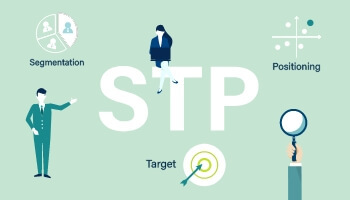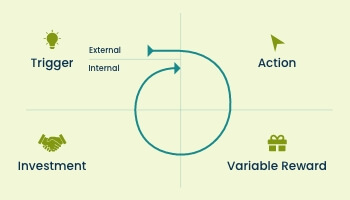When you think of marketing, there are probably two things that come to mind: tactics and strategies. But we often forget how vital the third part – the process/framework – is to create a successful, sustainable marketing strategy. In short, all our actions should be aligned with the business’s goals, even if it’s not “about sales.”
A great digital marketing framework model lets you lay out the goals, tactics, and actions you need to succeed with your marketing. When building a new marketing framework or improving on an existing one, it’s essential to consider that customers are at its core.
Marketing Framework Models
Marketing frameworks are prearranged structures or templates used to analyze and measure marketing strategies. Frameworks lessen the risk of trial and error and speed up campaign implementations and measurement.
Here are five marketing framework models to choose from:
1. 7Ps Marketing Mix


E. Jerome McCarthy created the 7P’s marketing mix in 1960. It stands for Product, Price, Place, Promotion, which was later extended to People, Process, and Physical Evidence by Booms and Bitner in 1982.
It is a holistic approach to marketing that can help organizations re-evaluate their marketing strategies and develop a clear plan of how all of the elements come together.
The 7P’s were designed to help businesses make decisions centered on the customer.
Product: The first P is for the product. A business must have something that meets the customer’s needs. This is the most important P in the entire marketing mix because if you don’t have anything good to sell, you won’t be able to sell anything at all!
Price: The second P is price. A business needs to determine what its customers are willing to pay for a product or service and ensure it meets their expectations without compromising profits.
Place: The third P is place. Your business needs to be accessible to customers who want to access products and services at all times without having any problems getting them where and when they need them the most – whether this means making sure your store stays open late into the night or offering a courier service
Promotion: How will people find out about your product or service? What marketing channels will you use? What will your advertising strategies be? Promotion methods could include advertising, sales promotions, special offers, personal selling, and public relations.
People: Who are the people involved in your business? These include workers as well as customers. Are they friendly and helpful? Do they understand what they’re doing? Do they know how to answer questions and solve problems should something go wrong? The people who work for you make up a big part of your image. These could be staff in a store or employees in an office. They could also be engineers who design new products or after-sales support staff who help customers with any problems.
Process: How does your business work? What steps do people have to go through to order products and services from you? Is that process easy? When a customer buys something from you, they do go through a process. For example, they might get advice from a salesperson, order goods online, or buy something from a vending machine. Your business processes will have an impact on how satisfied your customers are.
Physical Evidence: This part of the marketing mix refers to the tangible evidence that your product or service exists. This can include product packaging; store displays; advertising; corporate identity (website, business cards, and uniforms); product design, and so on.
2. STP Marketing Model


The STP Marketing Model was created by Herbert Hoover, an American engineer and businessman. The STP marketing model stands for segmentation, targeting, and positioning.
Segmentation: Segmentation refers to how you divide up your market — into categories like age, location, gender, or income level. The features can be geographic, demographic, psychographic, or behavioral.
Targeting: It is how you decide which segments to focus on—and which to ignore (i.e., it specifies which group(s) of people it will sell to).
Positioning: It is how you communicate with those chosen segments in order to make them want to purchase your offering instead of a competitor’s product. It also focuses on the potential customers to have in mind when they first hear your business name or product name (i.e., it’s all about perception).
3. Porter’s Five Forces


It is a framework for analyzing the competitive forces in an industry. You can use it to examine the state of a given industry and determine how attractive that sector is.
Porter described five fundamental forces that determine the nature of competition in an industry:
- Supplier Bargaining Power
- Buyer Bargaining Power
- Threat of Substitution
- Threat of New Entrant
- Rivalry among Existing Competitors
4. Lean Analytics Stages


Lean Analytics is a framework that helps startup founders focus on the right metrics and make decisions based on data, not assumptions.
It’s a bottom-up approach that will help you understand what to measure at each stage of your startup’s growth and how to use those metrics to help you make informed decisions about the direction of your business.
This model is based on the following five stages:
Adoption: When your prospect becomes aware of your business and decides they like it.
Activation: When your potential customer starts using your product or service and derives value from it.
Retention: When your customer comes back to your product again and again.
Referral: When your customer recommends you to others.
Revenue: When you start generating revenue from customers.
5. The Hook Model


When you want to start generating leads, you should use the Hook Model. The Hook Model helps you create a habit-forming product. This model guides you through building a product that your customers will come back to repeatedly
The Hook Model is a four-step process that brings customers to an intended action. First, a trigger prompts a customer’s need for your product or service. The stimulus can be external (e.g., seeing an ad) or internal (e.g., feeling hungry).
Then, the customer takes action by giving in to their immediate desire — often without thinking about it. For example, if you are craving ice cream, you might buy the first pint you see in the grocery store’s freezer aisle rather than comparing prices and reading reviews.
Next, the customer receives variable rewards depending on their product or service use. This process keeps them coming back and ultimately makes them want more of your product. For instance, your first Uber ride might only reward you with a clean car and a friendly driver; however, Uber might offer discounts or surprise gifts as rewards in later rides to keep you using their app and increase loyalty.
The final step is an investment, which involves putting something into your business so they will continue to use it. So, if you’re trying to get someone to follow your brand on social media after visiting your website once, then you could entice them by offering exclusive discounts for tracking your social media channels.
Wrapping up
Ultimately, a marketing framework is crucial in any good marketing strategy. A robust framework will guide you in all your marketing activities, and it will help you on your journey towards success. And that’s why a digital marketing company like Amura Marketing Technologies can be such a valuable partner to you. They help develop and implement effective strategies for your organization and ensure you get the most from your digital marketing initiatives.
